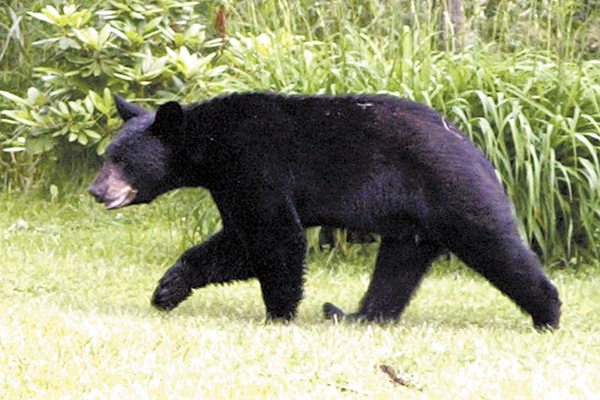Division of Wildlife biologist dispels myths about black bears


Sightings of black bears are on the upswing in Ohio, though just 50 to 100 black bears actually call the state their permanent home.
By EMMALEE C. TORISK
BOARDMAN
The frequently misunderstood black bear is the type of creature that would much rather flee from a situation than engage in confrontation.
It’s also an animal that, despite its intimidating teeth and claws and large size, is mostly shy and nonaggressive, choosing to defend itself only when cornered or startled.
And the best way to end a black bear’s pesky recurring visits? The answer is very rarely for officials to immobilize the bear with drug-laced darts. Simply remove whatever’s attracting the creature — usually bird feeders and garbage — and it will move on.
All of the above facts about the black bear, and a number of others, were shared during a free public program about the endangered animal and its increased presence in Ohio on Thursday at Boardman Park’s Lariccia Family Community Center. About 30 people attended the hourlong program, led by Bryan Kay, a private-lands biologist with District 3 of the Ohio Department of Natural Resources’ Division of Wildlife.
“We don’t want people to panic when they see a black bear,” Kay said. “Education goes a long way.”
Timing for the program couldn’t have been better.
A couple living on Waugh Drive in Hubbard told 21 WFMJ-TV, The Vindicator’s broadcast partner, they were startled by noises coming from outside their home about 11 p.m. Wednesday. Investigating the sounds, they discovered a bear near their backyard trash can.
Two nights earlier, Hubbard Township police received a report of a bear sighting on Creed Avenue. Over the weekend, another bear was spotted in the area of Bedford Road, according to the Hubbard City Police Department’s Facebook page.
Kay explained that black bear sightings have been on the upswing in Ohio for the past couple of years. In 2012, a record 140 sightings were reported. In 2013, there were 90.
The highest concentration of those sightings were in Northeast Ohio, Kay added, and in particular, places to the north of Mahoning County such as Ashtabula and Geauga counties.
Only about 50 to 100 black bears call Ohio their permanent home, however. Most of the black bears spotted in Ohio reside in Pennsylvania, which has a black bear population of about 16,000. It’s typically the young males who make this journey, traveling along major highway corridors and routinely trekking more than 100 miles.
Kay noted that most black bear sightings coincide with peak breeding season in June and July, and that positively identifying the animal before taking action is critical. The best way to do this is to learn what a black bear’s tracks, scat and claw marks look like, for example.
And when a bear is spotted, “let it be.”
“Let it go where it wants to go,” Kay said. “Enjoy it, but don’t approach it by any means.”
Karen McCallum, recreation director for Boardman Park, said she hopes the program rights some people’s misconceptions about black bears — misconceptions that are usually created by sensationalized media accounts of black bear encounters.
“You lose the fear when you learn about the animal,” she said.
McCallum added that other wildlife programs are in the works; the park recently hosted similar educational events about Canada geese and coyotes.
Jim and Sandy McKenna of Austintown were among those who attended Thursday’s program, and said they were prompted to do so after hearing about recent black bear sightings. Both said they enjoy learning about nature and found the program interesting.
They’d attend others like it, they said.
To report a black bear sighting, call the Ohio Division of Wildlife at 800-945-3543 (WILDLIFE).
 43
43
